March is Women’s History Month and a fitting time to reflect on women’s valuable contributions to the 1893 World’s Columbian Exposition.
Reprinted here is Part 1 of “Woman’s Part at the World’s Fair” from the May 1893 issue of The Review of Reviews. “The Work of the Board of Lady Managers” was written by one of its Vice Presidents, Virginia C. Meredith of Indiana. Parts 2 and 3 will follow later this month. Section headers and additional images have been added to the original article.
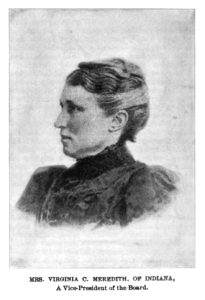
Virginia Claypool Meredith, Vice President of the Board of Lady Managers. (Image from The Review of Reviews, May 1893.)
WOMAN’S PART AT THE·WORLD’S FAIR.
I. THE WORK OF THE BOARD OF LADY MANAGERS
By Virginia C. Meredith
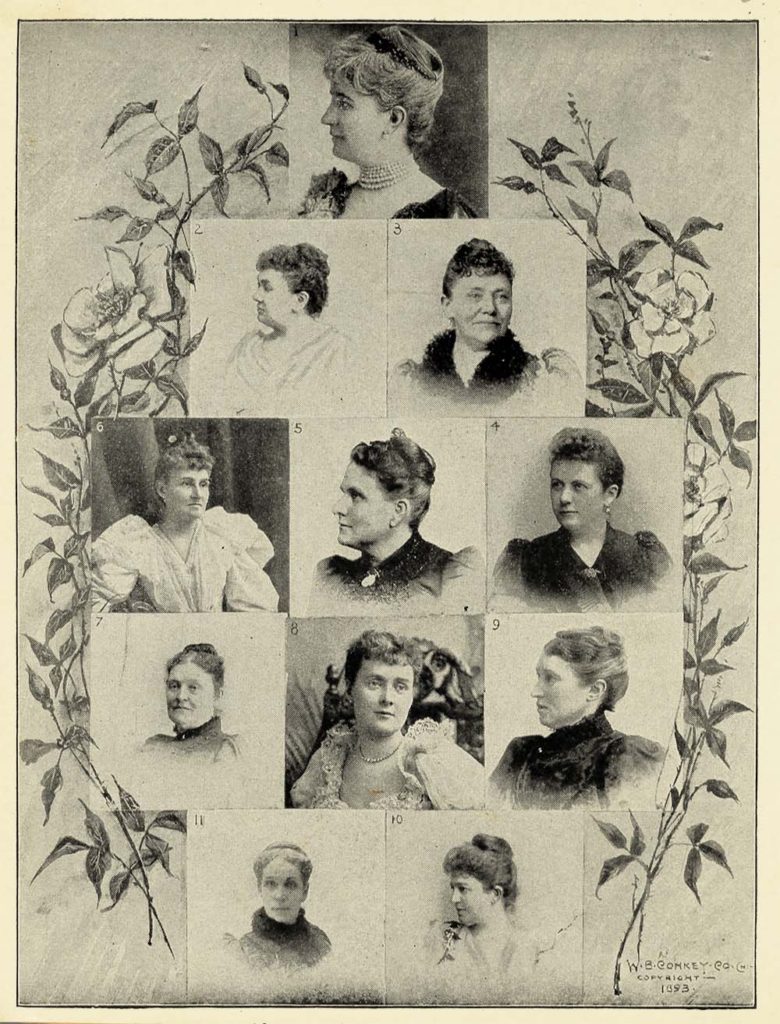
The Officers of the Board of Lady Managers (BLM) of the World’s Columbian Exposition. Key: 1. Mrs. Potter Palmer, President; 2. Mrs. Ralph Trautman, 1st Vice-President; 3. Mrs. Edwin C. Burleigh, 2nd Vice-President; 4. Mrs. Charles Price, 3rd Vice-President; 5. Miss Katherine L. Minor, 4th Vice-President; 6. Mrs. Beriah Wilkins, 5th Vice-President; 7. Mrs. Flora Beall Ginty, 7th Vice-President; 8.Mrs. Russel B. Harrison, Vice-President-at-large; 9. Mrs. Virginia C. Meredith, Vice Chairman Executive Committee; 10. Mrs. Susan Gale Cooke, Secretary; 11. Mrs. Helen M. Barker, Superintendent Ind. Dept. [Image from Views of the World’s Fair and Midway Plaisance. W. B. Conkey, 1894.]
Appropriations made by Congress
While the several appropriations made by Congress for the Columbian Exposition have been inadequate when viewed from the standpoint of the greatness of the event and the possibilities of the occasion, yet relatively the appropriations made by Congress for the use of the Board of Lady Managers have been extremely liberal. This liberality has dignified the Board in public estimation, and directed toward its aims and efforts an unusual degree of interest.
At this particular time the trend of thought seems toward plans and ideas which have to do with elevating the worth of the individual, and closely related to this is the subject of the industrial freedom of women. Traditional beliefs in regard to what constitutes a fit vocation or avocation for women are disappearing. Until the hand is free to do the mind cannot be free to think rationally, nor the creature free to live nobly. This is the philosophy that underlies an international industrial exposition. Something of this nature was implied when Congress, in creating the Board of Lady Managers, indicated but one duty, leaving others to be prescribed by the World’s Columbian Commission. The duty imposed by Congress is, “to appoint one or more members of all committees authorized to award prizes for exhibits which may be produced in whole or in part by female labor.” This recognizes both the right of the producer to representation in the important function of making awards for excellence, and also the fact that women have acquired a considerable place in industrial production and need to be sustained and protected in their industrial rights and privileges.[1]
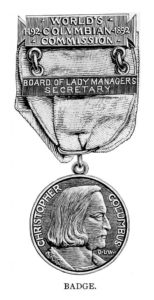
A Board of Lady Managers medal. [Image from Johnson, Rossiter A History of the World’s Columbian Exposition Volume 1 – Narrative. D. Appleton and Co., 1897.]
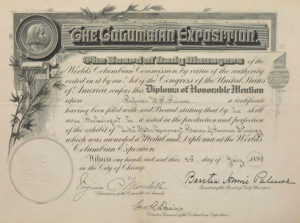
A Diploma of Honorable Mention from the Board of Lady Managers to Professor W.H. Holmes. [Image from Holmes, William Henry Random Records of a Lifetime, 1846-1931. 1872; Smithsonian Libraries.]
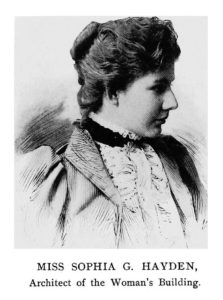
Woman’s Building architect Sophia Hayden. [Image from Johnson, Rossiter A History of the World’s Columbian Exposition Volume 1 – Narrative. D. Appleton and Co., 1897.]
A restful and refreshing point for the eye
The Woman’s Building in Jackson Park provided the opportunity for a woman to demonstrate her ability to grasp and execute a fine architectural idea. The building is of the style of the Italian Renaissance. The roof gardens and groups of figures standing on the roof line accent the points of beauty in the building itself. The whole effect is so chaste and delicate that among the colossal structures of the Exposition the Woman’s Building proves a restful and refreshing point for the eye. The architect is Miss Sophia G. Hayden of Boston. The interior has been decorated under the supervision of Mrs. Candace Wheeler and is in the same style as the building. The main decorations are in the rotunda or gallery and the two vestibules. In the gallery are six important decorative paintings.[2] The gallery is in ivory white with ornamental plaster work picked out with gold. A decorative band in an Italian design upon a gold background connects the two great pictures in either end of the gallery; under this band runs a series of panels, each bearing in gold letters the name of some woman distinguished in history, beginning on one side with the heroines of Bible history and on the other with queens famous for a career beneficial to mankind.[3] The panel under the great picture in the south end of the gallery carries the name of Sophia G. Hayden, architect, while the corresponding panel on the north bears the name of Bertha Honoré Palmer, President of the Board of Lady Managers.
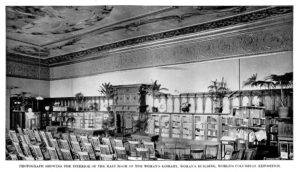
The Woman’s Building library. [Image from Campbell, James B. Campbell’s Illustrated History of the World’s Columbian Exposition, Volume II. M. Juul & Co., 1894.]
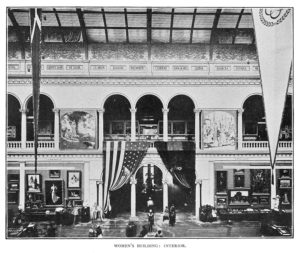
The main gallery of the Woman’s Building. [Image from Walton, William Art and Architecture of the World’s Fair. George Barrie & Son, 1893.]
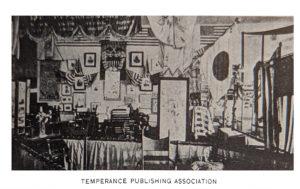
Photograph of the Temperance Publishing Association headquartered inside the Woman’s Building. [Image from Bancroft, Hubert Howe The Book of the Fair. The Bancroft Company, 1893.]
Distinguished women of all nations
The assembly hall on the north of the gallery will be used during the Exposition for instructive talks about exhibits and subjects of interest to women. These talks will be by distinguished women of all nations, and will occur at stated hours. A most interesting room on the south of the gallery is one devoted to headquarters for organizations of women; these represent the most advanced thought in education, the noblest endeavor in philanthropy and the loveliest work in charity. Many of these associations are international in scope.

State rooms and exhibits inside the Woman’s Building. [Image from Johnson, Rossiter A History of the World’s Columbian Exposition Volume 1 – Narrative. D. Appleton and Co., 1897.]
At an early period of its history the president of the Board of Lady Managers, Mrs. Potter Palmer, directed her efforts toward securing committees of representative women in all those nations which had accepted the invitation to paticipate [sic] in the Exposition. Almost all of these governments appointed committees of women, thus giving them official recognition. “The powerful organization thus secured extends around the world, and stands with perfect solidarity for the purpose of serving the interests of woman, and making industrial conditions easier for her.” Nothing in connection with the management of the Columbian Exposition parallels this brilliant effort at organization and co-operation among the nations. Tradition and conservatism in Europe and in the Orient have graciously united with the imperious New World, upon what would have been thought the most unlikely cause to enlist co-operation¾the industrial status of woman.
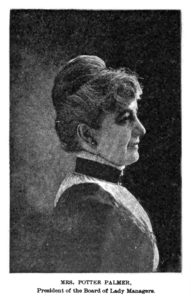
Bertha Honoré Palmer, President of the Board of Lady Managers [Image from The Review of Reviews, May 1893.]
A ship of destiny
It is earnestly hoped, and, indeed, fervently believed, that this organization will outlive the Columbian Exposition, and thereby the Board of Lady Managers will have proved a forceful influence in leading women everywhere to appreciate responsibility and inciting them to a proper share of thinking and doing. It is not possible to eliminate the element of error from an undertaking confronted with untried problems, as has been the work of the Board of Lady Managers; but if steadfastness of purpose, mental energy and alert projection into the future could guide, or rather could build, a ship of destiny, then this service has been performed for the Board by its president, Mrs. Bertha Honoré Palmer. To her must be ascribed the praise for projecting and directing the work upon lines that now seem destined to compel success and to form an interesting part of the history of the Columbian Exposition.
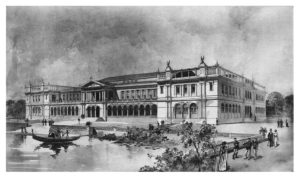
The Woman’s Building. [Image from The Review of Reviews, May 1893.]
NOTES
[1] For more about women inventors exhibiting at the Fair, see Pilato, Denise E. “Illumination or Illusion: Women Inventors at the 1893 World’s Columbian Fair” Journal of the Illinois State Historical Society 109, 4 (Winter), 2016, 374-99.
[2] The “six important decorative paintings” of the Gallery were: Mary Fairchild MacMonnies’ Primitive Woman (on north tympanum), Amanda Brewster Sewell’s Arcadia, and Lucia Fairchild’s The Women of Plymouth (on east wall), which depicted women in the past; and Mary Cassatt’s Modern Woman (on south wall), Lydia Emmet and Rosina Emmett Sherwood’s Art, Science, and Literature and The Republic’s Welcome to Her Daughters (on west wall), which depicted women of the present era.
[3] The names of some women “distinguished in history” included: George Sand, De Stael, Le Brun, Sevigne, Recamier, C. [Charlotte] Corday, Joan of Arc, Godiva, Boadicea, Hypatia, Rebecca, Ruth, Isabella, Elizabeth, and Victoria, among others.
[4] For more about the Woman’s Building library, see Wadsworth, Sarah; Wiegand, Wayne A. Right Here I See My Own Books: The Woman’s Building Library at the World’s Columbian Exposition. University of Massachusetts Press, 2012.

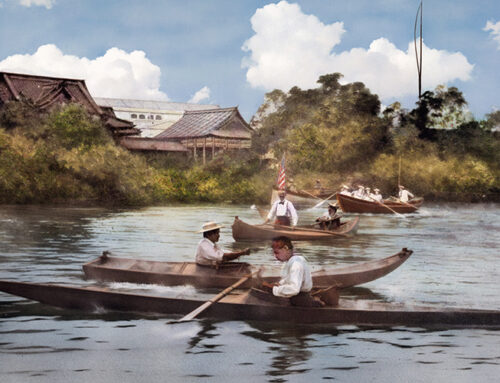
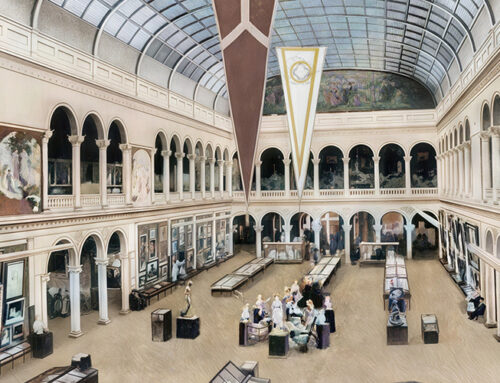
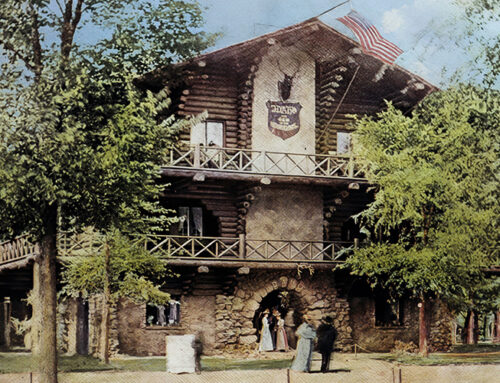
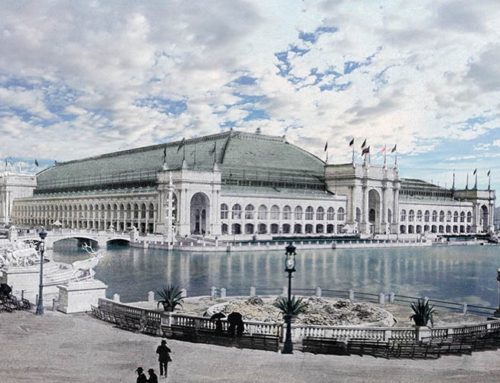
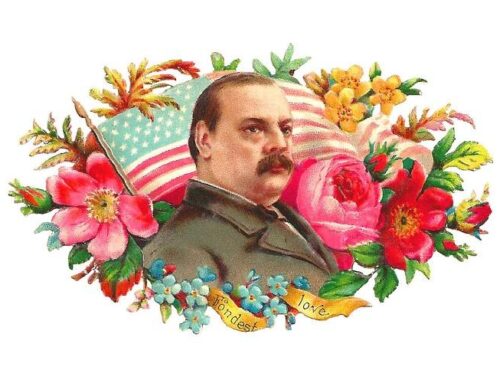
Leave A Comment